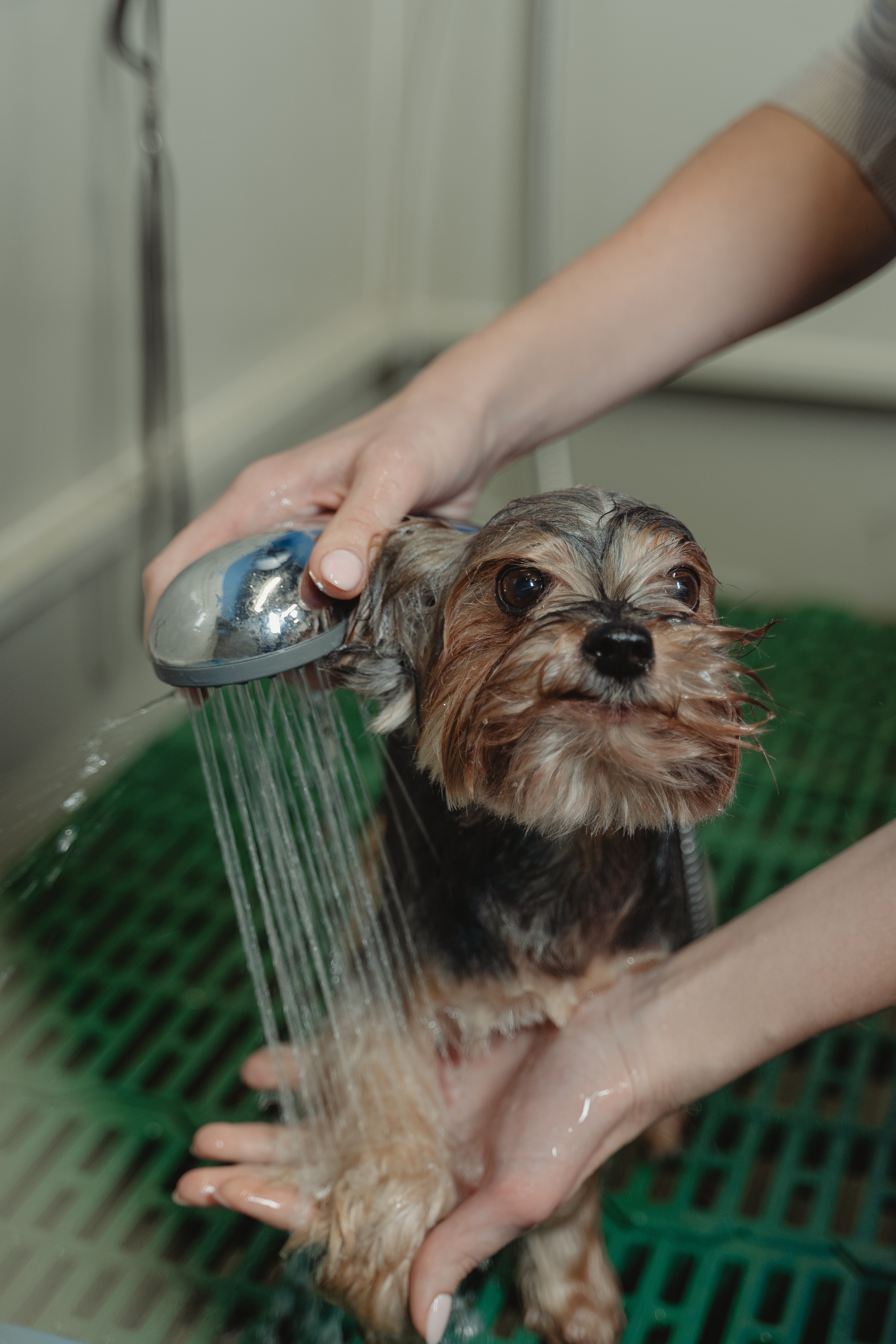Hiking with your dog can be an incredibly rewarding experience. Exploring nature together strengthens the bond between you and your furry friend while offering a chance for exercise and adventure. However, just like humans, dogs have specific needs while out on the trail. To ensure a safe and enjoyable hiking experience, here are ten essential items you should bring when hiking with your dog.
Leash and Collar/Harness
One of the most fundamental aspects of a successful hiking adventure with your dog is ensuring you have proper control over them throughout the journey. The leash and collar or harness are the essential tools to maintain this control, making them the first items you should consider when preparing for a hike with your furry companion.
The Leash:
A sturdy leash is your primary means of physically connecting with your dog while on the trail. It provides the necessary restraint to ensure your dog doesn’t wander off, chase wildlife, or approach other hikers without permission. For hiking, it’s generally recommended to use a leash that is at least six feet in length. This length provides a balance between giving your dog some freedom to explore and keeping them close for safety.
Collar or Harness:
Choosing between a collar and a harness depends on your dog’s breed, size, and behavior. Some dogs do well with a collar, while others benefit from the added control and comfort provided by a harness. Collars should fit snugly but not too tight, allowing you to fit two fingers between the collar and your dog’s neck comfortably. If you opt for a harness, make sure it is appropriately sized to avoid chafing or discomfort.
Remember that using a leash and collar or harness isn’t just about safety; it’s also about respecting the environment and other hikers. Properly controlling your dog ensures that you minimize your impact on wildlife and protect the enjoyment of fellow outdoor enthusiasts.
Before heading out on your hiking adventure, take the time to ensure that your dog is comfortable with their leash and collar or harness. Proper training and familiarization can make the hiking experience more enjoyable for both you and your furry friend. With the right equipment and training, you’ll be well-prepared to embark on a safe and enjoyable hiking journey with your dog.
Identification Tags
While we all hope for a seamless hiking adventure with our dogs, unexpected situations can sometimes lead to separation. That’s why attaching identification tags with your contact information to your dog’s collar is a vital precautionary measure to take before hitting the trails. These simple tags can be lifesavers in the event that you and your dog become separated during your hike.
- Contact Information: The most critical piece of information to include on your dog’s ID tag is your contact information. This typically includes your phone number and your name. Having this information readily available can make it much easier for someone who finds your dog to reach out to you and facilitate a reunion.
- Secondary Contact: If possible, consider adding a secondary contact person’s name and phone number to the tag. This could be a family member, friend, or neighbor who can assist in the event of an emergency.
- Home Address: While less critical than your phone number, including your home address on the tag can provide additional reassurance. If your dog is found close to your home, it can expedite their return.
- Microchipping: In addition to ID tags, consider microchipping your dog. Microchips are tiny electronic devices implanted beneath your dog’s skin, typically between the shoulder blades. They contain a unique identification number that can be scanned by a veterinarian or animal shelter. Be sure to keep your contact information associated with the microchip up-to-date.
- Durable and Legible: Ensure that the identification tag is durable and easy to read. Tags can become worn or damaged over time, so periodically check their condition and replace them if necessary. Legibility is crucial, especially in low-light conditions or if someone with impaired vision encounters your dog.
- Reflective or Glow-in-the-Dark Tags: For added safety, consider using reflective or glow-in-the-dark ID tags. These tags enhance your dog’s visibility, which can be particularly useful during hikes in low-light conditions or near roads.
- Keep Tags Updated: If your contact information changes, remember to update your dog’s ID tags accordingly. Many pet owners forget to do this, but it’s essential to ensure that the tags remain accurate and helpful.
When you and your dog are out on the trail, accidents, unforeseen circumstances, or even a sudden spook can lead to your dog becoming lost. In such situations, having visible identification tags on your dog can significantly increase the chances of a safe and speedy reunion. Many hikers, fellow dog owners, or park rangers are willing to help lost dogs, but they can do so much more effectively if they have access to your contact information.
Attaching identification tags with up-to-date contact information to your dog’s collar is a simple yet crucial step in ensuring your dog’s safety during a hike. This precaution can make all the difference in reuniting you and your furry companion if you ever become separated on the trail.
Proper Trail Maps
Before embarking on any hiking adventure with your dog, it’s essential to be well-prepared and knowledgeable about the trail you intend to explore. Proper trail maps play a central role in ensuring a safe and enjoyable journey for both you and your furry companion. Here’s why they are crucial and how to use them effectively:
1. Familiarity with the Trail:
- Study the Terrain: A detailed trail map provides information about the terrain, including elevation changes, water sources, and landmarks. Understanding the trail’s topography allows you to anticipate challenges and prepare accordingly.
- Navigation Aid: Trail maps are invaluable for navigation. They help you follow the correct path and avoid getting lost in unfamiliar terrain. This is especially important if the trail is not well-marked or if you’re hiking in an area with dense vegetation.
2. Dog-Friendly Trails:
- Identify Dog-Friendly Trails: Not all hiking trails are dog-friendly, and some may have restrictions or regulations regarding pets. Use the trail map to locate and choose routes that explicitly welcome dogs. These trails are more likely to have pet waste stations and other amenities.
- Respect Regulations: Even on dog-friendly trails, there may still be specific regulations, such as leash requirements or waste disposal rules. Your trail map should provide information on any such regulations, ensuring that you and your dog are in compliance.
3. Safety and Preparedness:
- Emergency Information: Trail maps often include emergency contact numbers and locations of nearby ranger stations or medical facilities. This information can be vital in case of an accident or emergency while hiking with your dog.
- Water Sources: Maps can indicate the locations of streams, rivers, or lakes where your dog can access water. Knowing these water sources is crucial, especially on longer hikes, to ensure your dog stays hydrated.
4. Planning Your Hike:
- Estimate Duration: Trail maps typically provide estimates of the time required to complete a trail. Use this information to plan your hike and ensure that it fits your schedule and fitness level.
- Trail Loops and Out-and-Back: Maps show the layout of the trail, allowing you to choose between loop hikes or out-and-back routes. This can help you tailor your hike to your dog’s endurance and preferences.
5. Alternative Routes and Bailout Points:
- Know the Options: Trail maps often include alternative routes and possible bailout points. Understanding these options can be helpful in case your dog experiences fatigue or if you encounter unexpected challenges on the trail.
6. Digital Maps and GPS:
- Digital Maps: In addition to paper maps, consider using digital trail maps and GPS devices or apps on your smartphone. These tools can provide real-time location information and help you stay on track, especially in areas with poor cell reception.
Proper trail maps are an indispensable part of your hiking gear when exploring with your dog. They provide valuable information about the trail’s terrain, regulations, safety, and emergency resources. By familiarizing yourself with the trail map and using it effectively, you can ensure a safer and more enjoyable hiking experience for both you and your four-legged companion. Always remember to respect the environment and follow Leave No Trace principles while using trail maps to navigate the great outdoors.
Water and Portable Bowl
Staying properly hydrated during a hike is crucial for both you and your four-legged hiking partner. Adequate hydration ensures that you and your dog maintain your energy levels, stay cool, and prevent heat-related issues. Here’s why water and a portable bowl are essential and why you might want to consider using a “dog water bottle” as a convenient hydration solution for your canine companion.
1. Importance of Hydration:
- Prevent Dehydration: Dehydration can be a significant concern for both humans and dogs during outdoor activities. While hiking, both you and your dog may sweat or pant to cool down, leading to the loss of essential fluids. Dehydration can result in fatigue, overheating, and even heatstroke.
- Energy and Endurance: Proper hydration is crucial for maintaining energy levels and stamina during a hike. The same applies to your dog, as staying hydrated helps them remain active and engaged throughout the journey.
2. Water Supply for Both:
- Sufficient Water: Before setting out on your hike, calculate the amount of water both you and your dog will need based on the trail’s length, temperature, and your respective sizes. It’s generally recommended to carry at least one liter of water per hour of hiking for yourself and an appropriate amount for your dog.
- Portable Bowl: While it’s possible to share your water with your dog, it’s more practical to bring a collapsible, lightweight bowl designed specifically for your furry friend. These bowls are easy to pack and allow your dog to drink comfortably without you having to cup water in your hands.
3. Managing Hydration on the Trail:
- Regular Breaks: Schedule regular breaks to offer water to your dog. It’s best to stop every 30 minutes to an hour to allow your dog to drink, especially in warm weather.
- Observe Your Dog: Pay attention to your dog’s behavior and body language. If they start panting excessively, seem fatigued, or are reluctant to continue, it may be a sign that they need water.
- Cool Water: Whenever possible, carry water that is not too cold. Extremely cold water can sometimes lead to stomach discomfort for dogs, especially when they’re hot and panting.
- Filter or Purify: If you plan to hike in an area where natural water sources are available, bring a water filter or purifying tablets to ensure that the water is safe for both you and your dog to drink.
4. Dog Water Bottle:
- Convenient Solution: A dog water bottle, also known as a pet travel water bottle or dog hydration bottle, is a specialized and convenient solution for keeping your dog hydrated during hikes. It’s designed with a built-in bowl or dispenser that allows your dog to drink directly from the bottle.
- Portability: Dog water bottles are compact and easy to carry. They often come with a clip or strap for attaching to your backpack or belt, making it readily accessible when your dog needs a drink.
- No Spillage: These bottles are designed to minimize water spillage, ensuring that you can control the amount of water your dog consumes. This can be particularly useful when water sources are scarce on the trail.
- Clean and Hygienic: Dog water bottles keep your dog’s water clean and free from contaminants. The water remains sealed within the bottle until your dog drinks from it, preventing dirt, debris, or bacteria from entering.
- Variety of Styles: Dog water bottles come in various styles, including squeeze bottles, gravity-fed bottles, and self-contained units with a bowl attached. Choose the one that best suits your and your dog’s preferences.
Water and a portable bowl are non-negotiable items for any hiking adventure with your dog. Proper hydration is essential for maintaining energy, preventing overheating, and ensuring a safe and enjoyable hiking experience. A dog water bottle can be a convenient and hygienic way to provide water for your canine companion on the trail. By planning ahead, managing water breaks, and observing your dog’s needs, you can help your furry friend stay well-hydrated and happy while exploring the great outdoors. Remember that a hydrated dog is a healthy and happy dog, and it’s your responsibility to ensure they have access to clean water throughout your hike.
Food and Treats
Proper nutrition is as crucial for your dog during a hike as it is for you. Ensuring that your dog has enough food and treats for the journey not only sustains their energy but also provides opportunities for positive reinforcement and training. Here’s why food and treats are essential and how to manage them effectively during your hike:
1. Sustained Energy:
- Caloric Requirements: Hiking is a physically demanding activity, and your dog will burn more calories than usual during the journey. It’s important to provide them with enough food to sustain their energy levels and prevent exhaustion.
- Fueling the Adventure: Just like you, your dog needs fuel to tackle the trail. The right food provides the necessary nutrients and calories to keep them active and engaged throughout the hike.
2. Adequate Provisions:
- Sufficient Food: Calculate the amount of food your dog will need based on the hike’s duration and your dog’s size and activity level. It’s advisable to bring a bit more than you think you’ll need, especially if the hike lasts longer than expected.
- Pack Extra: In case your hike extends beyond your original plan due to unforeseen circumstances or you encounter delays, having extra food ensures that your dog won’t go hungry.
3. Positive Reinforcement and Training:
- Treats as Rewards: Treats can be handy for positive reinforcement, particularly during training exercises or when navigating challenging terrain. Using treats as rewards reinforces good behavior and encourages your dog to follow commands on the trail.
- Motivation: Treats can serve as motivation for your dog, encouraging them to overcome obstacles or complete difficult sections of the hike.
4. Portable and Lightweight:
- Packability: When selecting dog food and treats for the hike, choose options that are easy to pack and won’t take up too much space in your backpack. There are many compact, lightweight dog food options available for outdoor adventures.
- Sealed Containers: Use airtight containers or resealable bags to store your dog’s food and treats. This keeps them fresh and prevents odors from attracting wildlife.
5. Meal Timing:
- Plan Meals: Depending on the duration of your hike, plan when to feed your dog. Some hikers prefer to feed their dogs a smaller meal before the hike and a larger one after, while others may feed smaller portions throughout the day.
- Avoid Overfeeding: Be cautious not to overfeed your dog, especially in warm weather. Overeating can lead to stomach issues or bloating, which can be uncomfortable and dangerous.
6. Hydration and Food Balance:
- Balance with Water: Coordinate your dog’s meals with water breaks to ensure they have access to both food and hydration. It’s a good practice to allow your dog to drink before and after eating.
7. Special Dietary Needs:
- Allergies and Restrictions: If your dog has specific dietary needs, allergies, or restrictions, ensure that the food and treats you bring are appropriate for them. There are many specialized dog food options available to accommodate various dietary requirements.
Food and treats are essential provisions when hiking with your dog. Adequate nutrition sustains your dog’s energy levels throughout the journey, and treats can be invaluable for positive reinforcement and training. By planning your dog’s meals, packing extra food, and choosing lightweight and packable options, you can ensure that your canine companion remains well-fed and motivated during your hiking adventure. Remember that a well-nourished dog is better equipped to enjoy the trail and share in the excitement of exploring the great outdoors with you.
Poop Bags
Responsible pet ownership extends to the great outdoors, and cleaning up after your dog is a fundamental aspect of maintaining the natural beauty of hiking trails and respecting fellow hikers. Carrying biodegradable poop bags is not only environmentally responsible but also ensures that you leave no trace of your visit. Here’s why poop bags are essential and how to use them effectively while hiking with your dog:
1. Leave No Trace:
- Environmental Stewardship: One of the key principles of Leave No Trace is to leave natural areas as you found them. This includes cleaning up after your dog. Dog waste left on the trail can harm the environment and disrupt local ecosystems.
- Preserve the Beauty: Hiking trails are often cherished for their pristine beauty. Responsible waste disposal helps preserve this beauty for future generations of hikers and nature enthusiasts.
2. Public Health and Safety:
- Human Health: Dog waste can contain harmful bacteria and parasites that can pose health risks to humans if not properly disposed of. By using poop bags, you protect the health and safety of other hikers.
- Animal Health: Proper waste disposal also benefits wildlife and other dogs. Leftover waste can attract wildlife or lead to territorial disputes among dogs.
3. Legal Requirements:
- Regulations: Many hiking trails and parks have specific regulations that require pet owners to clean up after their dogs. Failure to do so can result in fines or penalties.
4. Effective Use of Poop Bags:
- Carry Sufficient Bags: Ensure you have an adequate supply of biodegradable poop bags for the entire hike. It’s better to have more than you think you’ll need.
- Immediate Cleanup: Clean up after your dog as soon as they relieve themselves. Don’t leave waste behind, even if you plan to pick it up later.
- Securely Seal Bags: Double-bagging or securely sealing the poop bags helps contain odors and prevents any accidental leakage.
- Dispose Properly: Look for designated waste disposal bins or stations along the trail or at trailheads. If none are available, carry the waste with you until you find an appropriate disposal site.
- Don’t Leave Bags on the Trail: Leaving filled poop bags on the trail, even with the intention of picking them up later, is discouraged. It’s better to carry them with you until you can properly dispose of them.
- Follow Regulations: Be aware of specific regulations regarding dog waste in the area where you are hiking. Some parks or trails may have specific guidelines for disposal.
5. Biodegradable Bags:
- Eco-Friendly Choice: Choose biodegradable poop bags made from materials that break down naturally over time. These bags are an environmentally responsible choice and minimize the long-term impact of waste on the ecosystem.
Carrying biodegradable poop bags is an essential responsibility when hiking with your dog. Proper waste disposal ensures that you leave no trace, protects the environment, and respects fellow hikers and wildlife. By using poop bags effectively, you contribute to a cleaner, safer, and more enjoyable hiking experience for everyone, while also upholding the principles of responsible pet ownership and environmental stewardship.
Dog First Aid Kit
When hiking with your dog, it’s essential to be prepared for any unexpected situations or minor injuries that may occur on the trail. Just as you carry a first aid kit for yourself, having a well-equipped dog first aid kit is vital to ensure your furry friend’s safety and well-being. Here’s why a dog first aid kit is essential and what items you should include to address potential health issues while hiking:
1. Safety and Preparedness:
- Immediate Response: Accidents and injuries can happen quickly, whether it’s a minor cut, a splinter, or an encounter with an insect or tick. Having a dog first aid kit allows you to respond promptly to your dog’s needs.
- Reduce Discomfort: A well-stocked first aid kit can help alleviate your dog’s discomfort and prevent minor injuries from escalating into more significant problems.
2. Basic Dog First Aid Kit Essentials:
- Gauze and Adhesive Tape: Gauze pads and adhesive tape are essential for cleaning and covering wounds or cuts. They are also useful for creating a temporary bandage or wrap for injured paws or limbs.
- Antiseptic Wipes or Spray: Antiseptic wipes or spray help clean wounds and reduce the risk of infection. Use them to sanitize cuts, scrapes, or insect bites.
- Tweezers: Tweezers are handy for safely removing splinters, thorns, or ticks from your dog’s skin or fur. Make sure to remove ticks carefully and completely to prevent infection.
- Scissors: Scissors can be useful for trimming fur around wounds or removing tangled items from your dog’s coat.
- Cotton Balls or Swabs: These are useful for applying ointments or creams to wounds and for cleaning delicate areas around your dog’s eyes and ears.
- Sterile Saline Solution: Saline solution can be used to flush debris from your dog’s eyes or to clean wounds gently.
- Disposable Gloves: Wearing disposable gloves can help prevent the spread of infection and protect your hands when administering first aid.
- Instant Cold Packs: These can be used to reduce swelling in case of injuries like sprains or strains. Wrap the cold pack in a cloth or towel before applying it to your dog’s skin to prevent frostbite.
- Emergency Contact Information: Include a list of emergency contact numbers, including your veterinarian’s contact details, the nearest animal hospital or emergency clinic, and a local animal control number.
- Muzzle: In case your dog is in pain or distress and you need to provide first aid, a muzzle can help prevent accidental biting. Ensure it’s a comfortable, properly fitting muzzle designed for dogs.
- Any Necessary Medications: If your dog has specific medical conditions or requires medication, include these medications and instructions in the first aid kit.
3. Personalize the Kit:
- Dog’s Health Records: Carry a copy of your dog’s health records, including vaccination history and any allergies or medical conditions. These records can be valuable if you need to seek veterinary care during your hike.
- Emergency Blanket: An emergency blanket can help keep your dog warm in case of injury or shock.
4. Keep It Portable:
- Compact Container: Store your dog’s first aid kit in a waterproof and compact container or bag that’s easy to carry in your backpack.
5. Training and Knowledge:
- Learn Basic First Aid: Before heading out on a hike with your dog, take the time to learn basic dog first aid techniques. Knowing how to administer aid correctly is as important as having the supplies.
A dog first aid kit is a crucial component of your hiking gear when adventuring with your furry companion. Accidents can happen, and being prepared can make all the difference in ensuring your dog’s safety and comfort on the trail. By packing the essential items listed above and personalizing the kit to your dog’s specific needs, you’ll be well-equipped to handle common minor injuries or health issues that may arise during your hike. Remember that while a first aid kit is essential, prevention is also key. Keep a watchful eye on your dog, choose dog-friendly trails, and take precautions to minimize risks while enjoying your outdoor adventures together.
Safety Gear
When embarking on a hiking adventure with your dog, safety should be a top priority. Depending on the terrain, weather conditions, and the unique needs of your dog, consider additional safety gear to enhance your dog’s well-being and protect them from potential hazards. Here’s why safety gear is important and what items you may want to consider:
1. Tailored Protection:
- Terrain Considerations: Different hiking environments pose various challenges to your dog’s safety. Safety gear allows you to adapt and protect your dog accordingly.
2. Doggy Life Jacket:
- For Water Crossings: If your hike involves river crossings, lakes, or any significant water features, a doggy life jacket is essential, especially if your dog isn’t a strong swimmer. Even confident swimmers can benefit from the added buoyancy and safety.
- Safety in Unpredictable Waters: Fast currents or unexpected deep spots can catch dogs off guard. A life jacket provides peace of mind, allowing your dog to safely navigate water.
- Visibility: Opt for a life jacket in a bright color to enhance visibility. This makes it easier to spot your dog in the water and adds an extra layer of safety.
3. Reflective Vest:
- Low-Light Conditions: If you plan to hike during dawn, dusk, or in areas with low visibility, a reflective vest can help your dog stand out to other hikers and wildlife.
- Increased Visibility: Reflective materials bounce light from headlamps, flashlights, or headlights, making your dog more visible and reducing the risk of accidents.
4. Protective Booties:
- Rocky or Hot Terrain: Booties provide protection for your dog’s paws when hiking on rocky or scorching-hot surfaces. Sharp rocks, thorns, or hot sand can cause painful injuries to your dog’s paw pads.
- Cold Weather: In cold climates, booties can also insulate your dog’s paws and protect them from frostbite or ice-related injuries.
5. Paw Balm or Wax:
- Additional Paw Protection: In lieu of booties, consider carrying a paw balm or wax to apply to your dog’s paw pads. This can provide a layer of protection against rough terrain, hot surfaces, or snow and ice.
6. Safety Harness or Vest:
- Extra Control: For dogs that tend to pull or have a strong prey drive, a safety harness or vest with a handle on the back can provide better control in challenging situations.
- Assisting Your Dog: The handle can be used to help your dog navigate steep inclines or assist them in difficult terrain.
7. Dog-Specific Backpack:
- Even Load Distribution: A dog-specific backpack allows your dog to carry their own gear, such as water, snacks, or first aid supplies. It can help distribute weight evenly and make your dog feel like part of the adventure.
- Training Opportunity: Introduce your dog to the backpack gradually and ensure it doesn’t exceed 25-30% of their body weight.
8. Dog Sunglasses (Doggles):
- Eye Protection: Dog sunglasses, often referred to as “doggles,” can protect your dog’s eyes from bright sunlight, UV rays, wind, dust, or debris when hiking in open or windy areas.
- Eye Health: These are particularly useful for dogs with sensitive eyes or those prone to eye issues.
9. Safety Whistle or Bell:
- Location Awareness: Attach a safety whistle or bell to your dog’s collar to help locate them if they wander off or if visibility is low. The sound can be heard over a distance, making it easier to find your dog.
Safety gear for your dog can significantly enhance their protection and well-being during a hike. Depending on the specific conditions you’ll encounter, consider incorporating appropriate safety items to address potential hazards. Prioritize your dog’s comfort and safety to ensure a positive and secure hiking experience for both you and your furry companion. Always choose gear that suits your dog’s size, temperament, and the nature of the hike.
Dog Backpack
A dog-specific backpack is a versatile and practical accessory for hiking with your canine companion. It not only allows your dog to carry their gear but also helps distribute weight evenly, making the hiking experience more enjoyable and comfortable for your furry friend. Here’s why a dog backpack can be a valuable addition to your hiking gear and how to use it effectively:
- Weight Distribution: Just like you carry a backpack to distribute the weight of your gear, a dog backpack allows your dog to share the load. This can help reduce the physical strain on your dog during a long hike.
- Active Participation: Carrying their own gear can provide a sense of purpose for your dog, making them feel like an active part of the adventure.
2. Essential Items:
- Carry Dog Supplies: Your dog’s backpack can hold essential items such as their water, food, collapsible bowl, first aid kit, and even waste bags. This frees up space in your backpack and keeps your dog’s necessities easily accessible.
- Balance the Load: Distributing gear evenly between your backpack and your dog’s backpack helps maintain balance and ensures that both you and your dog are carrying the essentials.
3. Appropriate Weight Limitations:
- Follow Weight Guidelines: It’s crucial to adhere to weight guidelines when using a dog backpack. Typically, the load should not exceed 25-30% of your dog’s body weight. This ensures that your dog can comfortably carry the load without risking strain or injury.
- Gradual Introduction: If your dog is new to using a backpack, introduce it gradually. Start with a light load and monitor your dog’s comfort and behavior before increasing the weight.
4. Proper Fit and Adjustment:
- Choose the Right Size: Ensure that the backpack is the appropriate size for your dog. Measure your dog’s chest girth and back length to select the correct size.
- Adjust Straps: Adjust the straps on the backpack to ensure a snug but not tight fit. Pay attention to the chest and belly straps to prevent chafing or discomfort.
- Comfort is Key: Your dog should be able to move freely while wearing the backpack. Check for any signs of discomfort, such as rubbing or irritation, and make necessary adjustments.
5. Even Weight Distribution:
- Balanced Packing: Distribute the weight evenly on both sides of the backpack to maintain balance. Ensure that the heaviest items are placed close to your dog’s body to prevent shifting.
6. Supervision and Monitoring:
- Regular Checks: While your dog is wearing the backpack, periodically check for signs of fatigue or discomfort. Look for any changes in posture, gait, or behavior.
- Hydration Breaks: Make sure your dog has regular hydration breaks and monitor their water intake. Dogs wearing backpacks may need more frequent water stops.
7. Gradual Conditioning:
- Build Endurance: Before embarking on a long hike with a fully loaded backpack, gradually condition your dog by taking shorter hikes with lighter loads. This helps build their endurance and adaptability.
8. Safety Precautions:
- Safety Overload: Be cautious not to overload the backpack. Always prioritize your dog’s comfort and safety over carrying extra gear.
- Remove Backpack When Necessary: In challenging terrain or extreme weather conditions, consider removing the backpack temporarily to ensure your dog’s agility and safety.
9. Positive Association:
- Positive Experience: Associate the dog backpack with positive experiences by rewarding your dog when they wear it. Use treats, praise, and encouragement to create a positive association.
A dog backpack can be a valuable tool for hiking with your dog, allowing them to share the load and carry their essentials. However, it’s essential to use it responsibly, ensuring that the weight and fit are suitable for your dog. By following weight guidelines, adjusting the backpack correctly, and monitoring your dog’s comfort, you can enhance their hiking experience and make them an active and engaged participant in your outdoor adventures.
Dog Bed or Mat
Rest breaks during a hike are essential for both you and your dog to recharge and relax. Providing your dog with a portable dog bed or mat offers several benefits, including comfort, insulation from cold or wet ground, and a designated resting spot. Here’s why a dog bed or mat is a valuable addition to your hiking gear and how to make the most of it:
1. Comfort and Rest:
- Recharge Your Dog: Hiking can be physically demanding for your dog, just as it is for you. A comfortable dog bed or mat provides a cozy spot for your furry companion to rest, ensuring they have the energy to continue the hike.
- Prevent Fatigue: A designated resting place can help prevent your dog from becoming overly fatigued, especially on longer hikes. Giving your dog a comfortable spot to lie down encourages them to take breaks when needed.
2. Insulation from the Ground:
- Protection from Cold: In cooler or wet conditions, the ground can be cold and uncomfortable for your dog. A dog bed or mat provides insulation and prevents your dog from losing body heat to the ground.
- Stay Dry: When the ground is damp or wet, a dog bed or mat keeps your dog elevated and dry. This is particularly important for breeds with shorter coats.
3. Easy to Carry:
- Portability: Most dog beds or mats designed for hiking are lightweight and easily packable. They can be attached to your backpack or carried in a compact stuff sack.
- Convenience: Having a dedicated place for your dog to rest eliminates the need to search for suitable resting spots along the trail.
4. Protection from Insects and Debris:
- Elevated Surface: A dog bed or mat keeps your dog off the ground, reducing their exposure to insects, ticks, and debris. This can help prevent discomfort and potential insect bites.
5. Hygiene and Cleanliness:
- Easy to Clean: Many dog beds and mats are designed to be easy to clean. You can shake off dirt or debris and wipe them down if necessary.
- Maintain Cleanliness: By providing a designated resting place for your dog, you can help keep your dog clean and minimize the amount of dirt they carry into your tent or car.
6. Choose the Right Bed or Mat:
- Size and Portability: Select a dog bed or mat that suits your dog’s size and the available space in your backpack. It should be easy to pack and carry.
- Insulation: Consider the insulation properties of the bed or mat. Look for options that provide warmth in cooler conditions and breathability in warmer weather.
- Durability: Choose a bed or mat that is durable and resistant to wear and tear, especially if your hikes involve rugged terrain.
7. Comfort and Familiarity:
- Comfort Matters: Pay attention to your dog’s comfort and preferences. Some dogs may prefer a softer bed, while others are comfortable on a firmer mat.
- Familiarity: Introduce your dog to the bed or mat at home before using it on the trail. This helps your dog become accustomed to their designated resting spot.
8. Proper Cleaning and Maintenance:
- Regular Cleaning: Maintain the cleanliness of the bed or mat by shaking off dirt and debris during the hike. When you return home, clean it according to the manufacturer’s instructions.
9. Encourage Rest Breaks:
- Schedule Breaks: Plan rest breaks during your hike, and encourage your dog to use the bed or mat. Offer water and allow your dog to relax before continuing the journey.
A portable dog bed or mat is a thoughtful addition to your hiking gear, providing your dog with a comfortable and insulated resting spot during breaks. It ensures your furry companion remains refreshed and ready to continue the adventure, enhancing their overall hiking experience. By selecting the right bed or mat and introducing it to your dog before your hike, you can help them feel comfortable and secure in their designated resting area while exploring the great outdoors together.
Conclusion
Hiking with your dog can be a remarkable adventure, but it’s essential to come prepared. Bringing these ten essential items, along with an attitude of responsibility and respect for the environment, will help ensure a safe and enjoyable experience for both you and your furry companion. So, grab your gear, leash up your dog, and hit the trails for unforgettable adventures in the great outdoors.










